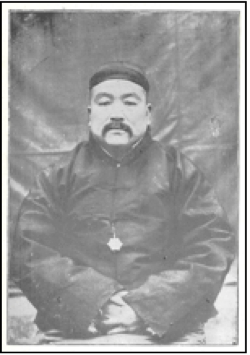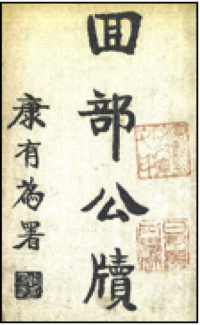|
||||||||||
|
FEATURESFive Races, One Parliament Minority Representation in the Early RepublicDavid Brophy The Australian National UniversityThere are various ways that geographical delineations can be applied to modern China's geography; there are natural boundaries, provincial boundaries and military boundaries, as well as the socially constructed boundaries that find no simple correlate in lines on maps. The early years of the Republic of China saw a new template added to these possible configurations; it was one based on the electoral divisions legislated in the constitution of China's first parliaments. We might with hindsight describe such institutions as 'stillborn', but at the time they provoked considerable debate as to how best to depict the nation's different regions and peoples, and how those who were to be their political representatives should be elected. Considering this debate might therefore help identify some of the tensions underlying the early creation of the republic. Xinjiang reflects the difficulties facing the nation as a whole. Although it was home to a large non-Han majority, as a province it was required to adhere to the same administrative principles that were being applied elsewhere in a nascent modern China. Here, the homogenizing tendencies of the new nation-state clashed with the social realities of its periphery. Xinjiang in 1911 was not the single administrative unit that the Xinjiang Uyghur Autonomous Region is today. Some territories which today form part of Xinjiang were not yet subject to Ürümchi's authority, others were only nominally so. In particular there was contestation between Ürümchi and Ili, the province's 'window to the west'. It was there, in Ili, and not in Ürümchi that the Xinhai Revolution won its greatest victory, with Hubei revolutionaries taking control and declaring themselves for the republic (for details, see Ghulja 1912: A Chronicle from the Russian Muslim Press in this issue). To the south, the uprising degenerated into a campaign of terrorism against officials, and to the north Russians quietly encouraged the Mongols of the Altay to secede and join a newly independent Mongolia. When, in the middle of 1912, provincial authority virtually fell into the lap of Yang Zengxin, the northwest was a fractious region whose fate had by no means been decided. Given this chaotic situation—one hardly unique in 1912 China—it stands as testimony to the faith that reformists had in constitutional rule that they insisted on holding nation-wide elections so soon after the fall of the Qing. After convening a Provisional Senate in May 1912 more elaborate regulations on elections were issued by Beijing for the creation of a bicameral body with quotas of delegates from each province, Mongolia, Tibet and Qinghai, and the overseas Chinese. Unfortunately, practicalities meant that some of these plans on paper remained a dead letter. Obviously, elections could not be held in Outer Mongolia, which had expelled Chinese officials. Nor did it prove possible to conduct elections in Tibet. Instead, control over these seats was left to loyal Mongolian princes and members of the Tibetan clergy in Beijing, part of Yuan Shikai's concessions intended to staunch China's secessionist wounds. Although these negotiations clearly owe much to the Qing legacy, the new emphasis on 'a union of five races' (wuzu gonghe 五族共和) meant that the electoral system was interpreted, by some at least, as something different, a system of ethnic representation and of quotas (zhuan'e 專額) for each of China's five constituent races. Thus, delegates from Mongol territories were thought of as representatives of the Mongols as a race, those from Tibet as representative of all Tibetans, and so forth. Among the western Mongols, the 'Old' Torghud were alone in enjoying a right to delegates, a legacy of their prestigious position within the Qing. But there were many other Mongol groups living alongside Torghud in the Altay and elsewhere in Xinjiang. In recognition of this Yuan Shikai issued a decree that Ürümchi should coordinate efforts with officials in Altay and Khobdo to formulate mutually agreeable electoral rules to cover these groups. Such decrees seemed to indicate that an 'ethnic principle' might be applied to elections across Xinjiang. At one point Yuan even floated the idea of placing all the Mongols of Altay, Xinjiang, Alashan and Qinghai under the rubric of 'Western Mongolia.'[1] Yet this proposal was rejected by the National Assembly, which argued that as a province Xinjiang was not entitled to such special treatment. In response to a telegram from Ürümchi querying how elections in the multinational Ili district were to be conducted, Xinjiang officials were instructed that 'there are to be no racial distinctions'.[2] This position was weakened, however, when statutes on elections in Mongolian territories (issued in December 1912) were 'accidentally' sent to Ili. Five electorates were soon drawn up for Xinjiang's various Torghud, Chahar and Ölöd Mongols. The following month, when a report on these preparations reached Beijing, the mistake was revealed, and Ili was informed that all such special districts for non-Han groups were to be abolished. Soon, the diverse population of Ili was making its opinions known directly, as excerpts from these telegrams to the capital in 1912 show: From the Kazakhs: 'The Torghud have three deputies, why are there none for the more than 180,000 Kazakhs? We know this is unjust. We look upon the Great President as God, why does he neglect us?'  Fig.1 Li Qian 李謙 If, as these sentiments indicate, the new constitution looked like a system of ethnic quotas, albeit an imperfect one, then we can imagine how China's Muslims must have felt when they looked at the assembly's composition. Of all of China's 'five races' the Hui 回 seemed the most disadvantaged; as they lacked a quota entirely it could be argued that they were completely disenfranchised. Grumblings about this were heard as early as 1912 and, in 1916, during elections to the Second Session of the National Assembly, a campaign for Muslim representation was initiated by a Muslim from Henan by the name of Li Qian 李謙.[Fig.1] Li Qian got his start in politics through a relationship with the hereditary Muslim prince of Hami, Shah Maqsud, during a visit to the capital made by the Xinjiang dignitary in 1914. Li was a military man, serving at the time in Yuan Shikai's bodyguard, and he was assigned to host the president's Muslim guest. When Shah Maqsud left Beijing, he appointed Li Qian as his 'representative'.[4] Before too long, Li was speaking on behalf of all the Muslim nobility of Xinjiang, that is to say petitioning Yuan on their behalf in early 1916 for his accession to the imperial throne. Li proceeded to appoint himself the 'plenipotentiary representative of the Muslim Region' (Huibu quanquan daibiao 回部全權代表), setting up his office at a mosque in Beijing's inner west. From here, he set about petitioning the president for Muslim seats in the National Assembly. Li's petitions demonstrate the fluidity of concepts of political geography and community that were prevalent in the early post-Xinhai years. Beginning with the premise of wuzu gonghe, he laments the fact that although provisions were made to ensure Mongolian and Tibetan participation in the parliament, no such concern was shown towards the nation's Muslims. Since, he pointed out, the electoral provisions for Mongolia were grounded in the institution of the banner fiefdoms (qi 旗), the existence of a comparable Muslim aristocracy in Xinjiang entailed that they too were entitled to the same rights.  Fig.2 The title page of Huibu gongdu Hence Li's emphasis was on a territorialised notion of Muslims as an integral part of China, inhabitants of the 'Muslim Region' Huibu 回部, a distinct territory on par with the Mongol and Tibetan lands. Li gave his correspondence, which he published in 1924, the title Official Papers on the Muslim Region (Huibu Gongdu 回部公牘). Pursuing this geographic line of argument, Li held that since the Huibu was two-thirds the size of Mongolia, two-thirds of the twenty-seven Mongolian deputies would allow for eighteen from the Huibu. Tibet was only half the size of the Huibu, so its ten deputies would in theory correspond to twenty from the Huibu.[5][Fig.2] Li's campaign raised eyebrows in Beijing and although upon enquiry the prince of Hami did acknowledge his ties with Li, he would not endorse his political campaign. Xinjiang's governor Yang Zengxin did not look kindly on lines of communication between Xinjiang and Beijing that were beyond his control, and he may well have intervened behind the scenes. The lack of support did not deter Li, however; his letters indicate that his campaign was well received by Muslims elsewhere in China, even if his military background made him a little uncouth for the Muslim literati of the capital. Political trends were, nonetheless, not working in his favour. By the early 1920s ideas related to wuzu gonghe were losing ground to more monogenetic, if not outright assimilationist, theories of China's ethnic composition. Experiments with parliamentary democracy were soon to be curtailed too. Within China, the space to imagine a different political geography for China's Muslim northwest was becoming increasingly restricted. Li's path was one of many that, in the first decade of post-imperial China, eventually led to a dead end, but the logic that drew him along it was not thereby refuted. Today, when calls from China's ethnic minorities for national self-determination are countered with arguments of unworkability and accusations of splittism, the idea of a Chinese parliamentary system filled by ethnic quotas surely does not come across as such an untenable idea. Other articles included in this feature:
Notes:[1] 'Yi zeng Ximeng ji Huibu canyiyuan' 議增西蒙及回部參議院, Fazheng zazhi vol.1, no.12 (1912): 97-98. [2] 'Choubei guohui shiwuju zhi Xinjiang dudu dian' 籌備國會事務局致新疆都督電, Zhengfu gongbao, 6 November 1912, p.9. [3] 'Choubei guohui shiwuju zhi Xinjiang dudu, Kebuduo canzan, Aertai banshi zhangguan dian' 籌備國會事務局致新疆都督、科布多參贊、阿爾泰辦事長官電, Zhengfu gongbao, 1 March 1913, pp.25-26. [4] Pang Shiqian 龎士謙, Aiji jiunian 埃及九年, Beijing: Yuehua Wenhua Fuwushe, 1951, pp.61-62. [5] Li Qian 李謙, Huibu gongdu 回部公牘, Shanghai: Zhonghua Yinshua Chang, 1924, pp.2-4. |